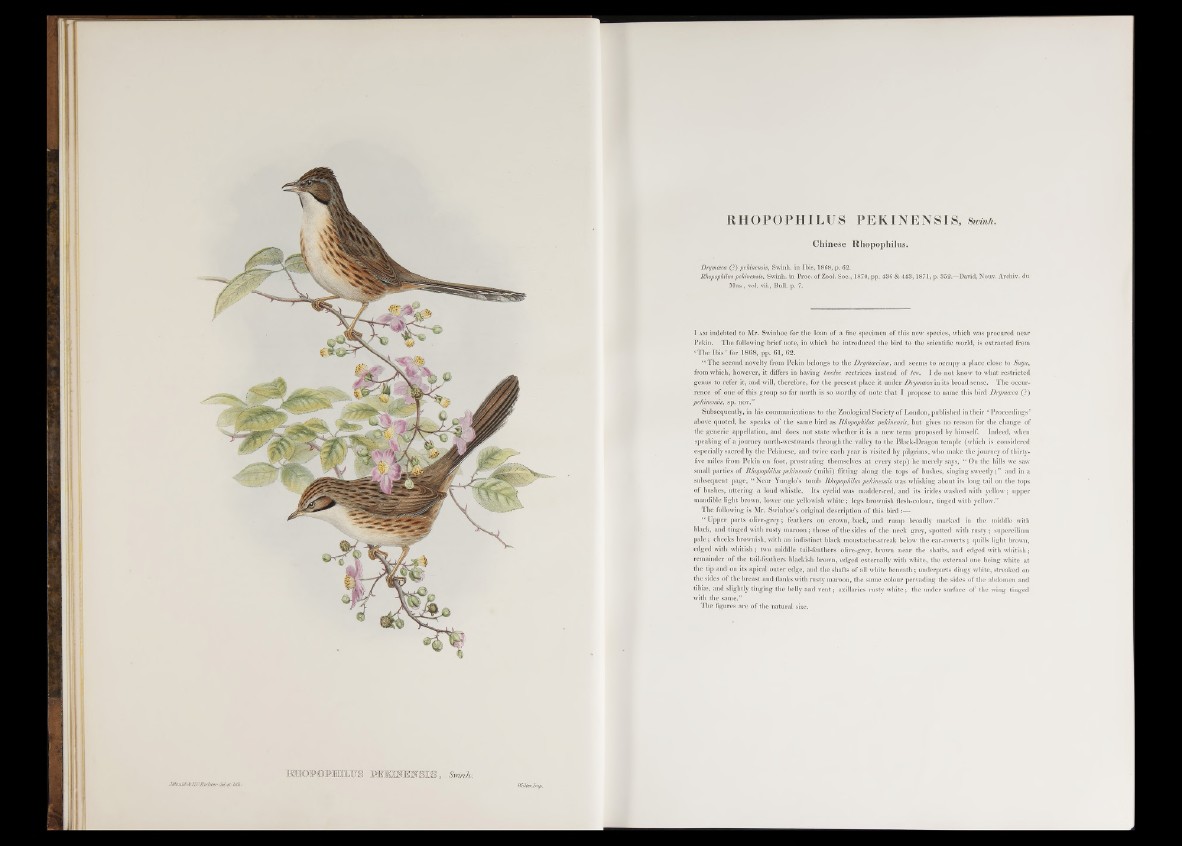
p SwirJ-i/
JRoulcU&ICCRichter Uc^eOTith/. W ahet'Jinp.
RHOPOPHILUS PEKINENSIS, Swinh.
Chinese Rhopophilus.
Drymceca (?) pekinensis, Swinh. in Ibis, 1868, p. 62.
Rhopophilus pekinensis. Swinh. in Proc. of Zool. Soc., 1870, pp. 436 & 443,1871, p. 352.—David, Nouv. Archiv, du
Mus, vol. vii., Bull. p. 7.
I am indebted to Mr. Swinhoe for the loan o f a fine specimen of this new species, which was procured near
Pekin. The following brief note, in which he introduced the bird to the scientific world, is extracted from
‘ The Ib is’ for 1868, pp. 61, 62.
“ The second novelty from Pekin belongs to the Drynicecince, and seems to occupy a place,close to Suya,
from which, however, it differs in having twelve rectrices instead of ten. I do not know to what restricted
genus to refer it, and will, therefore, for the present place it under Drymceca in its broad sense. The occurrence
of one of this group so far north is so worthy o f note that I propose to name this bird Drymceca (?)
pe/cinensis, sp. nov.”
Subsequently, in his communications to the Zoological Society of London, published in their ‘ Proceedings’
above quoted, he speaks of the same bird as Rhopophilus pekinensis, but gives no reason for the change of
the generic appellation, and does not state whether it is a new term proposed by himself. Indeed, when
speaking of a journey north-westwards through the valley to the Black-Dragon temple (which is considered
especially sacred by the Pekinese, and twice each year is visited by pilgrims, who make the journey of thirty-
five miles from Pekin on foot, prostrating themselves at every step) he merely says, “ On the hills we saw
small parties of Rhopophiluspeldnetisis (mihi) flitting along the tops of bushes, singing sweetly;” and in a
subsequent page, “ Near Yunglo’s tomb Rhopophilus pekinensis was whisking about its long tail on the tops
o f bushes, uttering a loud whistle. Its eyelid was madder-red, and its irides washed with yellow; upper
mandible light brown, lower one yellowish white; legs brownish flesh-colour, tinged with yellow.”
The following is Mr. Swinhoe’s original description of this bird;:-*—
“ Upper parts olive-grey; feathers on crown, back, and rump broadly marked in the middle with
black, and tinged with rusty maroon; those of the sides of the neck grey, spotted with ru sty ; supercilium
p a le ; cheeks brownish, with an indistinct black moustache-streak below the ear-coverts; quills light brown,
edged with whitish; two middle tail-feathers olive-grey, brown near the shafts, and edged with whitish;
remainder of the tail-feathers blackish brown, edged externally with white, the external one being white at
the tip and on its apical outer edge, and the shafts of all white beneath; underparts dingy white, streaked on
the sides of the breast and flanks with rusty maroon, the same colour pervading the sides of the abdomen and
tibiae, and slightly tinging the belly and v en t; axillaries rusty white; the under surface of the wing tinged
with the same.’’
The figures are of the natural size.